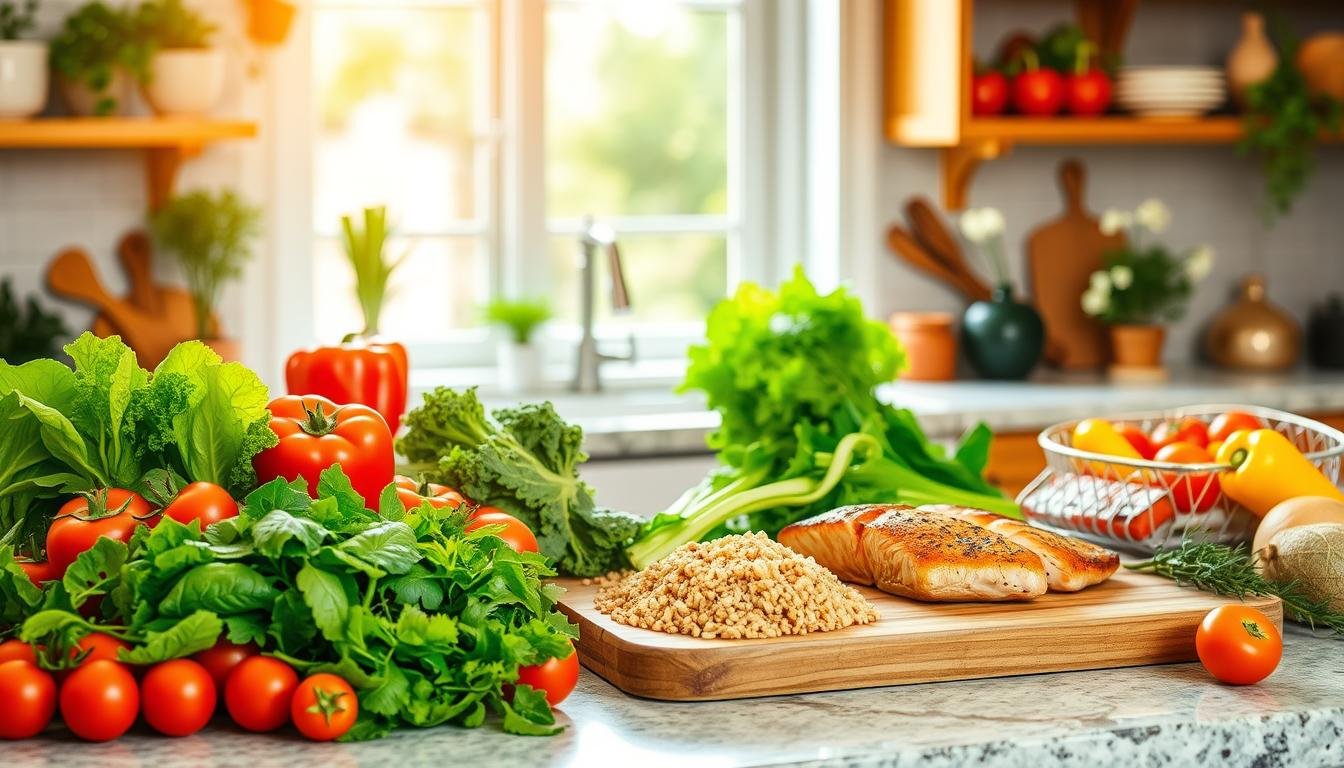In the United States, a growing number of people are turning to nourishing meals to improve their health and wellbeing. The rise of various diets and nutrition trends highlights the importance of the food we eat. It plays a significant role in our quality of life.
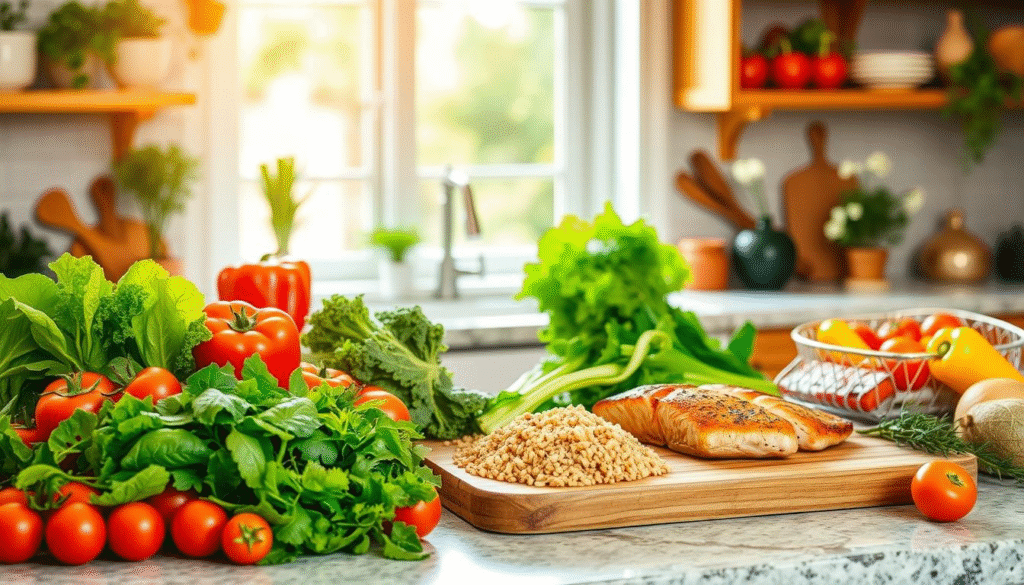
The Mediterranean diet has gained popularity in recent years, and for good reason. It focuses on whole grains, fruits, vegetables, and lean proteins. This approach helps individuals create a balanced and satisfying diet, rich in nutrients.
Key Takeaways
- Emphasizing whole grains, fruits, and vegetables in your diet
- Incorporating lean proteins and healthy fats into your meals
- Exploring the benefits of the Mediterranean diet
- Discovering new and exciting healthy meal ideas
- Creating a balanced and nourishing eating plan
The Foundations of Healthy Cooking
Healthy cooking transcends mere recipe-following; it’s about crafting meals that fuel the body. Grasping nutrition basics is vital for making smart kitchen choices.
Understanding Nutritional Balance
Attaining nutritional balance involves mixing macronutrients and micronutrients in the correct ratios. Macronutrients fuel energy and support growth. Micronutrients, on the other hand, enable various bodily functions.
Macronutrients and Micronutrients
Macronutrients encompass carbohydrates, proteins, and fats. Carbs serve as the main energy source, proteins aid in repair and growth, and fats are vital for bodily functions. Micronutrients, such as vitamins and minerals, are critical for health maintenance.
Creating Well-Rounded Meals
To craft balanced meals, mix a variety of foods. Include vegetables, fruits, whole grains, lean proteins, and healthy fats. This variety ensures a wide nutrient intake. Adopting clean eating recipes can streamline this process.
Essential Kitchen Tools for Healthy Meal Preparation
Proper kitchen tools simplify healthy cooking. Must-haves include a chef’s knife, cutting boards, pots, pans, and utensils. These tools aid in preparing low-calorie meals without compromising taste.
Stocking a Healthy Pantry
A well-stocked pantry is essential for healthy cooking. It should hold whole grains, canned beans, nuts, seeds, and diverse spices. These staples are fundamental for low-calorie meals and clean eating recipes. With these ingredients, you can whip up a plethora of nutritious dishes.
Healthy Recipes for Quick Breakfasts
Quick and healthy breakfast recipes are a game-changer for busy mornings. With a little planning, you can enjoy a nutritious start to your day without sacrificing flavor or spending too much time in the kitchen.
Overnight Oats Variations
Overnight oats are a perfect breakfast solution for those in a hurry. They’re easy to prepare and can be customized with various ingredients to suit your taste preferences.
Berry Almond Overnight Oats
Combine rolled oats, almond milk, and mixed berries in a jar. Top with sliced almonds and a drizzle of honey for a delicious and gluten-free breakfast.
Chocolate Banana Protein Oats
Mix oats with banana, protein powder, and cocoa powder, then top with sliced banana and a sprinkle of cinnamon. This breakfast is not only tasty but also packed with protein to keep you energized.
Protein-Packed Smoothie Bowls
Smoothie bowls are another quick and nutritious breakfast option. Blend your favorite fruits with protein powder and milk, then top with granola, nuts, and fresh fruit. This breakfast is rich in protein and can be made gluten-free.
Savory Breakfast Options
For those who prefer a savory breakfast, consider making a breakfast burrito with scrambled eggs, black beans, and avocado, or a breakfast skillet with sautéed vegetables and lean protein. These options are not only flavorful but also provide a satisfying start to your day.
Energizing Lunch Ideas for Busy Days
Busy days demand meals that are both quick and nutritious. Incorporating plant-based cooking into your meal prep is a smart move. It ensures you get essential nutrients while enjoying a variety of flavors and textures.
Mason Jar Salads
Mason jar salads are a convenient and healthy choice for busy lunches. They can be made ahead of time and are easy to take on the go.
Mediterranean Chickpea Salad
A Mediterranean Chickpea Salad, with chickpeas, cherry tomatoes, cucumber, and feta cheese, is a satisfying option. It’s packed with protein and fiber, making it a great choice for a filling lunch.
Asian-Inspired Quinoa Salad
An Asian-Inspired Quinoa Salad, with quinoa, edamame, and a tangy soy sauce dressing, is another excellent choice. Quinoa, being a complete protein, paired with edamame, makes for a meal that’s both energizing and nutritious.
Hearty Soups and Stews
Hearty soups and stews are ideal for a quick and nourishing lunch. They can be made in large batches and reheated as needed. A lentil soup or a vegetable stew offers both comfort and health benefits.
Nutritious Wraps and Sandwiches
Nutritious wraps and sandwiches are perfect for busy days. Opt for whole grain wraps and fill them with various vegetables, lean proteins, and healthy spreads. A hummus and avocado wrap is a delicious and energizing choice.
Satisfying Dinner Recipes for the Whole Family
Dinner time is a chance to unite the family with meals that are both nourishing and enjoyable. Creating a meal that’s healthy yet satisfying is achievable with a few strategies. It’s about finding the right balance.
One-Pan Protein and Vegetable Dishes
One-pan meals are a smart choice for dinner, as they cut down on cleanup and enhance flavors. Two excellent options stand out.
Sheet Pan Lemon Herb Chicken with Roasted Vegetables
This dish marries lemon’s brightness with herbs’ richness, making it a heart-healthy delight. Season chicken breasts with salt, pepper, and herbs, then roast with veggies like Brussels sprouts and carrots.
One-Skillet Mediterranean Fish
Mediterranean fish dishes are packed with health benefits, thanks to olive oil, garlic, and fresh veggies. Cook fish fillets with sliced tomatoes, olives, and capers for a quick, nutritious dinner.
Healthy Pasta Alternatives
For a break from regular pasta, try zucchini noodles or spaghetti squash. These alternatives are lower in carbs and pair well with various sauces and toppings.
Flavorful Fish and Seafood Options
Fish and seafood are not just tasty but also rich in omega-3s, vital for heart health. Grilling or baking fish with a marinade of olive oil, lemon juice, and herbs makes for a flavorful, heart-healthy meal.
By adding these dinner recipes to your routine, your family can enjoy satisfying, nutritious meals together.
Plant-Based Cooking Essentials
Exploring plant-based cooking can lead to discovering new favorite dishes that are both healthy and satisfying. With the rise of vegetarian and vegan diets, understanding the essentials of plant-based cooking has become increasingly important.
Protein Sources for Vegetarian and Vegan Diets
Protein is a critical component of a balanced diet. For vegetarians and vegans, it’s essential to know the various plant-based protein sources. These include legumes, tofu, tempeh, and seitan. Nuts and seeds, such as almonds and chia seeds, are also excellent sources.
Creating Satisfying Meatless Meals
Meatless meals can be just as satisfying as their meat-containing counterparts with the right ingredients and recipes. Here are a couple of examples:
Lentil and Vegetable Curry
This dish is not only flavorful but also packed with protein and fiber. Simply sauté onions, garlic, and your choice of vegetables, then add lentils and a can of coconut milk, simmering until the lentils are tender.
Stuffed Bell Peppers with Quinoa
Fill bell peppers with a mixture of cooked quinoa, black beans, diced tomatoes, and your favorite spices, and bake until the peppers are tender. This dish is a complete meal in one.
Plant-Based Substitutions for Common Ingredients
Adapting your favorite recipes to be plant-based is easier than you think. Here are some common substitutions:
| Ingredient | Plant-Based Substitution |
| Dairy Milk | Almond milk, soy milk, or oat milk |
| Eggs | Flaxseed eggs or chia eggs |
| Cheese | Vegan cheese or nutritional yeast |
By incorporating these plant-based cooking essentials into your meal prep ideas, you’ll be able to create a variety of healthy recipes that are both nourishing and delicious.
Gluten-Free Dishes Made Simple
Discover the simplicity of preparing gluten-free dishes that are both nutritious and tasty. Clean eating recipes can be easily adapted to gluten-free, ensuring a healthy and enjoyable dining experience.
Understanding Gluten-Free Ingredients
Gluten-free ingredients are essential for those with gluten intolerance or sensitivity. Ancient grains like quinoa and amaranth are excellent sources of nutrients and are naturally gluten-free.
Gluten-Free Grains and Alternatives
Exploring gluten-free grains can be a rewarding experience. Options include rice, corn, and gluten-free oats. Cauliflower rice is a popular low-carb alternative.
Cauliflower Rice Stir-Fry
A simple and delicious recipe involves pulsing cauliflower in a food processor until it resembles rice, then sautéing it with your favorite vegetables and seasonings.
Almond Flour Baking Basics
Almond flour is a versatile gluten-free baking option. It’s ideal for making cakes, cookies, and pastries. Ensure to combine it with the right ratio of eggs and leavening agents for the best results.
| Gluten-Free Grain | Nutritional Benefit | Culinary Use |
| Quinoa | High in Protein | Salads, Sides |
| Cauliflower Rice | Low in Carbs | Stir-Fries, Low-Carb Dishes |
| Almond Flour | Rich in Healthy Fats | Baking, Desserts |
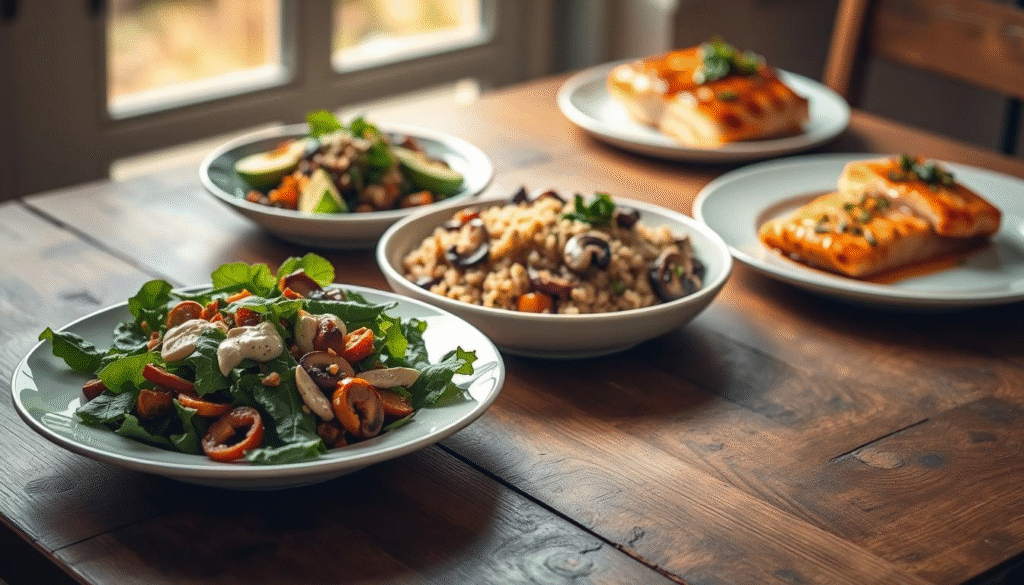
Adapting Favorite Recipes to Gluten-Free
Many favorite recipes can be adapted to gluten-free by substituting gluten-containing ingredients with gluten-free alternatives. Experiment with different gluten-free flours to find the best fit for your recipes.
Heart-Healthy Options for Cardiovascular Wellness
Eating for heart health is more than just avoiding unhealthy foods. It’s about adding nutrient-rich options that boost cardiovascular wellness. A diet filled with fruits, vegetables, whole grains, and lean proteins is key to heart health.
Foods That Support Heart Health
Adding foods known to support heart health is essential for cardiovascular wellness. Leafy greens like spinach and kale are packed with antioxidants. Fatty fish, such as salmon, are rich in omega-3 fatty acids. Nuts and seeds, like almonds and flaxseeds, offer healthy fats and antioxidants.
Reducing Sodium Without Sacrificing Flavor
Lowering sodium intake is critical for heart health, yet it doesn’t mean flavor has to suffer. There are effective ways to balance these two.
Herb and Spice Blends
Herb and spice blends can add depth and warmth to dishes without sodium. Try garlic and rosemary or thyme and lemon to enhance flavors.
Citrus and Vinegar Flavor Enhancers
Citrus fruits and vinegar can also boost flavor. A squeeze of fresh lemon or orange juice, or a splash of vinegar, can brighten dishes and reduce salt needs.
Healthy Fats and Their Benefits
Healthy fats, found in avocados, olive oil, and nuts, are vital for heart health. They lower bad cholesterol and provide sustained energy.
| Food | Benefits |
| Avocados | Rich in monounsaturated fats, which help lower bad cholesterol |
| Olive Oil | High in antioxidants and monounsaturated fats, supporting heart health |
| Nuts and Seeds | Good source of healthy fats and antioxidants |
By adding these heart-healthy options to your diet, along with choosing low-calorie meals, you can greatly support cardiovascular wellness.
Low-Calorie Meals That Don’t Sacrifice Taste
The idea that low-calorie meals must be bland is a common misconception. It’s actually possible to enjoy both flavor and health without excessive calories. By focusing on volume eating strategies, you can eat foods that are low in calories but high in volume. This makes you feel full without consuming too many calories.
Volume Eating Strategies
Volume eating centers around whole grains, vegetables, and lean proteins. These foods are not only filling but also packed with nutrients. For example, starting a meal with a salad or a broth-based soup can greatly reduce calorie intake.
Flavor-Boosting Techniques Without Added Calories
To enhance flavor without adding calories, several methods are effective. Roasting and caramelization reveal the natural sweetness in vegetables. Herbs and spices add depth without the need for salt or sugar.
Roasting and Caramelization
Roasting vegetables like Brussels sprouts or carrots enhances their flavor and texture. It makes them a tasty side dish. Caramelization, achieved through slow cooking, brings out natural sugars, adding a rich taste.
Herbs and Spices for Maximum Impact
Herbs and spices can greatly improve the taste of low-calorie meals. Basil and oregano add a Mediterranean flair, while cumin and chili powder give dishes a spicy kick.
Portion Control Tips and Tricks
Even with healthy, low-calorie foods, portion control is key. Using smaller plates and being mindful of serving sizes helps manage calorie intake. Eating slowly and savoring each bite also leads to greater satisfaction with less food.
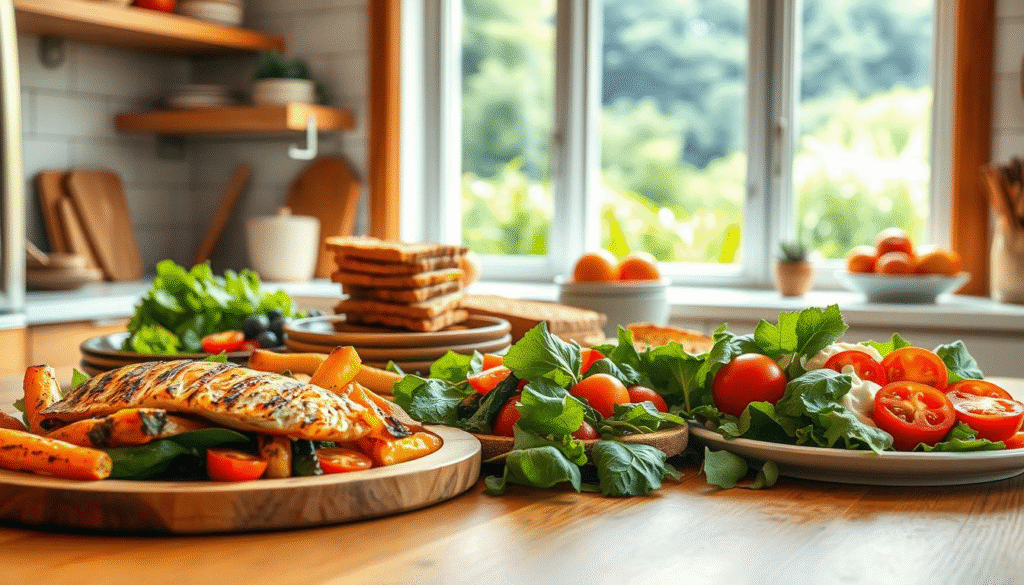
Smart Meal Prep Ideas for Busy Weeks
Meal prep is a transformative strategy for those with hectic schedules, enabling the enjoyment of healthy meals without the daily cooking burden. By allocating a few hours on weekends for meal prep, you can significantly reduce your weekly cooking time. This approach ensures you consume nutritious, homemade dishes consistently.
Weekend Prep Routines
Embarking on a meal prep journey with a meticulously planned weekend routine is transformative. It involves dedicating time for batch cooking and efficient meal preparation.
Batch Cooking Fundamentals
Batch cooking is a cornerstone of meal prep, involving the preparation of large quantities of ingredients or meals. These can be reheated or repurposed throughout the week. Focus on plant-based cooking by preparing grains, beans, and roasted vegetables in bulk.
Efficient Chopping and Preparation
Efficient chopping and preparation are essential for successful meal prep. Invest in high-quality knives and cutting boards. Learn various chopping techniques to expedite your prep time. Prepare a variety of vegetables and proteins that can be combined in different ways.
Freezer-Friendly Healthy Recipes
Freezer-friendly meals are invaluable during hectic weeks. Prepare heart-healthy options like soups, stews, and casseroles for freezing and reheating as needed. Label and date your frozen meals for easy identification.
Mix-and-Match Components for Varied Meals
To prevent meal prep monotony, prepare components that can be mixed and matched to create diverse meals. Cook a variety of proteins, grains, and vegetables that can be combined in different ways. This strategy keeps your meals engaging and ensures a balanced diet.
Healthy Snacks and Appetizers
Choosing nutrient-rich snacks is essential for a healthy lifestyle. These snacks should not only curb your cravings but also boost your energy and support your overall health. By incorporating easy meal prep ideas into your snack routine, you can make healthy snacking more convenient and accessible.
Energy-Boosting Snack Ideas
Energy-boosting snacks are ideal for a quick energy boost between meals. Here are a few ideas to get you started:
No-Bake Energy Bites
No-bake energy bites are a simple and nutritious snack made from ingredients like oats, nuts, and dried fruits. They’re easy to prepare and can be customized with your favorite ingredients.
Roasted Chickpeas and Nuts
Roasting chickpeas and nuts brings out their natural flavors and adds a satisfying crunch. Season them with herbs and spices for added flavor without extra calories.
Nutritious Dips and Spreads
Dips and spreads are versatile and can be made with a variety of healthy ingredients. They’re perfect for snacking with vegetables, whole grain crackers, or as part of a meal prep.
Smart Choices for Sweet Cravings
Satisfying your sweet tooth doesn’t have to mean sacrificing nutrition. Opt for snacks that are naturally sweet or make your own treats using healthier alternatives to refined sugars.
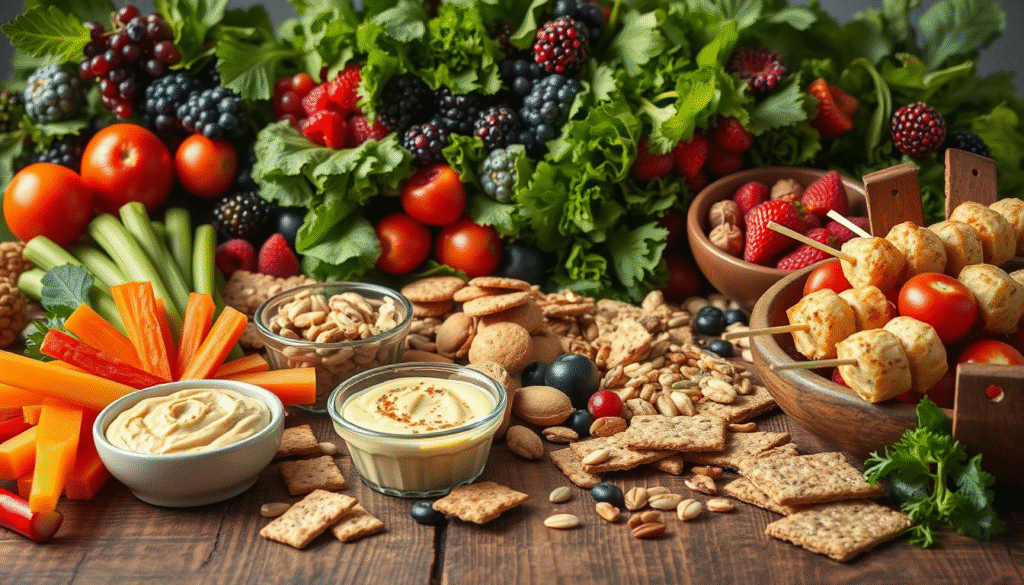
By incorporating these healthy snack and appetizer ideas into your diet, you can enjoy a more balanced and satisfying eating experience. Remember, the key is to focus on nutrient-dense foods and easy meal prep ideas that make healthy choices more accessible.
Mindful Eating and Healthy Recipe Enjoyment
Embracing mindful eating can revolutionize how we enjoy healthy recipes. It makes us more present and aware during meals. This way, we can truly appreciate the food we consume.
Creating a Positive Relationship with Food
Building a positive relationship with food means understanding our hunger and fullness signals. It also involves eating slowly and savoring each bite. This mindful approach helps us fully appreciate healthy recipes.
Savoring Meals and Practicing Gratitude
Savoring meals is not just about taste; it’s about valuing the effort in meal preparation. Practicing gratitude during meals can make the experience more enjoyable and fulfilling.
Balancing Nutrition and Pleasure
Finding a balance between nutrition and pleasure is essential for a healthy food relationship. Healthy recipes can be both nutritious and delicious. This allows us to enjoy our meals while also nourishing our bodies.
Conclusion
Healthy eating doesn’t have to be complicated, thanks to the wealth of clean eating recipes available. We’ve explored various aspects of healthy cooking, from nutritional balance to meal prep strategies. Understanding these foundations allows you to create nourishing meals that are both delicious and easy to prepare.

Key takeaways include the importance of stocking a healthy pantry, utilizing plant-based protein sources, and adopting mindful eating practices. Clean eating recipes simplify healthy cooking, ensuring your meals are flavorful and satisfying. By incorporating these principles into your daily routine, you can enjoy a balanced diet that supports overall wellness.
As you continue on your journey to healthy eating, remember that the key to success lies in simplicity and consistency. Experiment with new clean eating recipes and meal prep ideas to find what works best for you.
Sources
The data in this article comes from trusted sources in health and nutrition. For more information and to dive deeper into the topics, check out these resources:
- American Heart Association: Offers guidance on heart-healthy eating and living.
- Mayo Clinic: Provides extensive health and wellness information, including healthy recipes and nutrition advice.
- Harvard T.H. Chan School of Public Health: Shares insights into healthy eating patterns and nutrition research.
These sources are known for their dedication to accurate and unbiased health information. They support the healthy recipes and nutrition advice in this article.
FAQ
What are some healthy recipes for quick breakfasts?
Quick breakfasts can be healthy with overnight oats, protein-packed smoothie bowls, and savory dishes. These can all be made gluten-free, perfect for clean eating.
How can I make healthy meal prep easier?
For easier meal prep, start with weekend prep routines. Use mix-and-match components for varied meals. Incorporate plant-based and heart-healthy options.
What are some low-calorie meal ideas that don’t sacrifice taste?
Low-calorie meals can be tasty with volume eating and flavor-boosting techniques. Use portion control tips and tricks, even for gluten-free dishes.
What are some healthy snack options?
Healthy snacks include energy-boosting ideas, nutritious dips, and smart sweet choices. These can be prepared with easy meal prep ideas.
How can I make heart-healthy choices when cooking?
Choose heart-healthy foods, reduce sodium without losing flavor, and use healthy fats. These tips apply to low-calorie meals.
What are some plant-based protein sources?
Plant-based proteins include legumes, beans, lentils, tofu, tempeh, and seitan. They’re great for meatless meals and vegetarian/vegan diets.
How can I adapt my favorite recipes to be gluten-free?
To make recipes gluten-free, learn about gluten-free ingredients. Use gluten-free grains and alternatives. Adjust recipes to keep them flavorful and satisfying.
What are some tips for practicing mindful eating?
Mindful eating involves creating a positive food relationship. Savor meals and practice gratitude. Balance nutrition with pleasure for healthy enjoyment.
